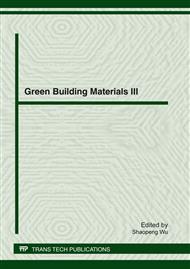p.162
p.168
p.175
p.181
p.189
p.194
p.203
p.209
p.215
Study of High Temperature Performance and Low Temperature Property on Layered Silicate Modified Asphalt Concrete
Abstract:
Montmorillonite (MMT), a typical layered silicate, has been widely used to prepare modified asphalt. This paper investigates the high temperature performance and low temperature property on layered silicate modified asphalt concrete. The control concrete is prepared by base asphalt. Meanwhile, three-point bending, conventional and SHRP rutting tests are used to compare the properties of the two types of asphalt concrete. The results of conventional and SHRP rutting tests show that the modified asphalt concrete exhibits a better high temperature performance than the control concrete. And the maximum bending strength of modified asphalt concrete is higher than that of control concrete at the same temperature. It can be concluded that both the high temperature performance and low temperature property of asphalt concrete has been improved efficiently by utilization of layered silicate modified asphalt.
Info:
Periodical:
Pages:
189-193
Citation:
Online since:
April 2012
Authors:
Price:
Сopyright:
© 2012 Trans Tech Publications Ltd. All Rights Reserved
Share:
Citation:


